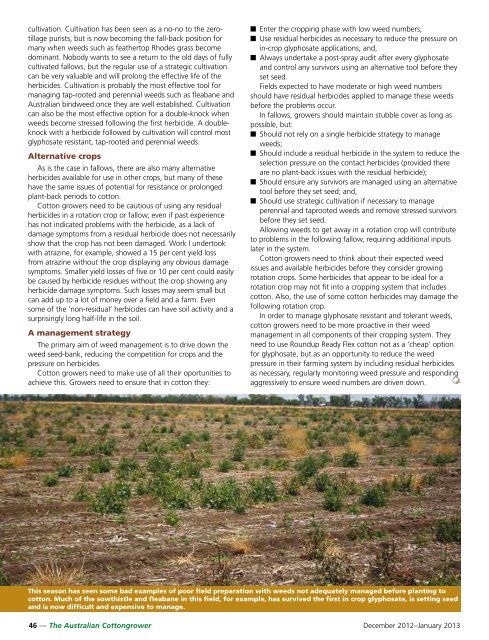cotton - Greenmount Press
cotton - Greenmount Press
cotton - Greenmount Press
You also want an ePaper? Increase the reach of your titles
YUMPU automatically turns print PDFs into web optimized ePapers that Google loves.
cultivation. Cultivation has been seen as a no-no to the zerotillage<br />
purists, but is now becoming the fall-back position for<br />
many when weeds such as feathertop Rhodes grass become<br />
dominant. Nobody wants to see a return to the old days of fully<br />
cultivated fallows, but the regular use of a strategic cultivation<br />
can be very valuable and will prolong the effective life of the<br />
herbicides. Cultivation is probably the most effective tool for<br />
managing tap-rooted and perennial weeds such as fleabane and<br />
Australian bindweed once they are well established. Cultivation<br />
can also be the most effective option for a double-knock when<br />
weeds become stressed following the first herbicide. A doubleknock<br />
with a herbicide followed by cultivation will control most<br />
glyphosate resistant, tap-rooted and perennial weeds.<br />
Alternative crops<br />
As is the case in fallows, there are also many alternative<br />
herbicides available for use in other crops, but many of these<br />
have the same issues of potential for resistance or prolonged<br />
plant-back periods to <strong>cotton</strong>.<br />
Cotton growers need to be cautious of using any residual<br />
herbicides in a rotation crop or fallow, even if past experience<br />
has not indicated problems with the herbicide, as a lack of<br />
damage symptoms from a residual herbicide does not necessarily<br />
show that the crop has not been damaged. Work I undertook<br />
with atrazine, for example, showed a 15 per cent yield loss<br />
from atrazine without the crop displaying any obvious damage<br />
symptoms. Smaller yield losses of five or 10 per cent could easily<br />
be caused by herbicide residues without the crop showing any<br />
herbicide damage symptoms. Such losses may seem small but<br />
can add up to a lot of money over a field and a farm. Even<br />
some of the ‘non-residual’ herbicides can have soil activity and a<br />
surprisingly long half-life in the soil.<br />
A management strategy<br />
The primary aim of weed management is to drive down the<br />
weed seed-bank, reducing the competition for crops and the<br />
pressure on herbicides.<br />
Cotton growers need to make use of all their oportunities to<br />
achieve this. Growers need to ensure that in <strong>cotton</strong> they:<br />
■ Enter the cropping phase with low weed numbers;<br />
■ Use residual herbicides as necessary to reduce the pressure on<br />
in-crop glyphosate applications; and,<br />
■ Always undertake a post-spray audit after every glyphosate<br />
and control any survivors using an alternative tool before they<br />
set seed.<br />
Fields expected to have moderate or high weed numbers<br />
should have residual herbicides applied to manage these weeds<br />
before the problems occur.<br />
In fallows, growers should maintain stubble cover as long as<br />
possible, but:<br />
■ Should not rely on a single herbicide strategy to manage<br />
weeds;<br />
■ Should include a residual herbicide in the system to reduce the<br />
selection pressure on the contact herbicides (provided there<br />
are no plant-back issues with the residual herbicide);<br />
■ Should ensure any survivors are managed using an alternative<br />
tool before they set seed; and,<br />
■ Should use strategic cultivation if necessary to manage<br />
perennial and taprooted weeds and remove stressed survivors<br />
before they set seed.<br />
Allowing weeds to get away in a rotation crop will contribute<br />
to problems in the following fallow, requiring additional inputs<br />
later in the system.<br />
Cotton growers need to think about their expected weed<br />
issues and available herbicides before they consider growing<br />
rotation crops. Some herbicides that appear to be ideal for a<br />
rotation crop may not fit into a cropping system that includes<br />
<strong>cotton</strong>. Also, the use of some <strong>cotton</strong> herbicides may damage the<br />
following rotation crop.<br />
In order to manage glyphosate resistant and tolerant weeds,<br />
<strong>cotton</strong> growers need to be more proactive in their weed<br />
management in all components of their cropping system. They<br />
need to use Roundup Ready Flex <strong>cotton</strong> not as a ‘cheap’ option<br />
for glyphosate, but as an opportunity to reduce the weed<br />
pressure in their farming system by including residual herbicides<br />
as necessary, regularly monitoring weed pressure and responding<br />
aggressively to ensure weed numbers are driven down.<br />
This season has seen some bad examples of poor field preparation with weeds not adequately managed before planting to<br />
<strong>cotton</strong>. Much of the sowthistle and fleabane in this field, for example, has survived the first in - crop glyphosate, is setting seed<br />
and is now difficult and expensive to manage.<br />
46 — The Australian Cottongrower December 2012–January 2013

















